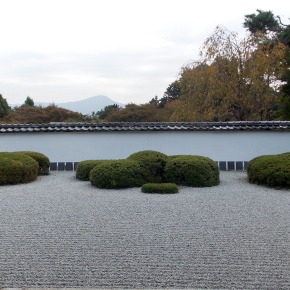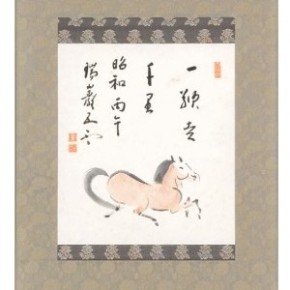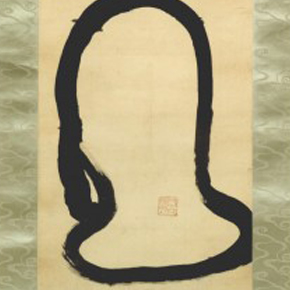We have a fine example of calligraphy by the beggar poet and Zen drunk Taneda Santoka (#226.) Santoka’s Zen was not the Zen of temples, robes, and ceremonies but the Zen of “See into your nature to become Buddha.” Santoka could not adhere closely to the trappings of Zen, but he plunged into the mountains … Continue reading
Category Archives: Zen Art
Simple Is Best: Part Two
Zen brushwork is abstract, suggestive, and two-dimensional. Zen gardening is concrete, direct, and three-dimensional. The best-known Zen garden is at Ryoan-ji in Kyoto. It is formed by rocks, moss, and sand. The arrangement of the rocks is carefully planned, but their placement seems perfectly natural—they are right where they should be. Since the garden incorporates … Continue reading
Simple Is Best
The guiding principle in Zen practice and its expression in art is: “Simple is best.” The best expression of Zen brushwork is the simplest form possible—a circle. Interpretation of the Zen circle, the enso, can be complex, profound, even convoluted. Or it does not have to be explained at all, only contemplated. Creation of an … Continue reading
Zen Horse
For each New Year, Zen abbots typically brush a calligraphy or painting appropriate for that year’s zodiac animal on small paper boards (shikishi) that are distributed to each of the temple’s patrons. 2014 is the Year of the Horse. Goun, abbot of Zuigan-ji in Matsushima, was famed for his Zenga of zodiac animals. We have … Continue reading
The Compassionate Mother Who Nurtures Children
Among the new scrolls in the gallery is a “Zen Madonna and Child” by Sengai, an appropriate scroll for Christmas. It is believed that Buddhist artists adopted this theme of mother and child not long after the Jesuits introduced the image to Japan in the 16th century. The infant in Sendai’s zenga is cuddled close … Continue reading
Zen Ecology
In the gallery there is a calligraphy piece by Takeda Mokurai that reads, “Heaven is high, all the elements are in order.” In other words, the cosmos is perfectly ordered so the best course of action for human beings is to let nature be. The Zen ideal is to interfere as little as possible with … Continue reading
Sit Still, Work Hard
The Rule of Saint Benedict states that ora et labora, “pray and work,” is the basis of Christian monasticism. Contemplation of the mysteries of faith must be combined with physical labor—for example, farming, brewing beer, making cheese, spinning wool. Prayer and work must be in balance. In Zen Buddhism, the guiding principle is “Sit still, … Continue reading
Wall-Gazing Daruma
While there are many “in-your-face, I have always got my eyes on you” Daruma Zenga in the gallery, there is also one wall-gazing Daruma painting by Nantembo. Prior to appearing in public, Daruma was said to have sat facing the wall in deep meditation (that lasted nine years) in a cave at Shorinji. In other … Continue reading
The Year of the Snake
The year of the dragon has turned into the year of the snake. The dragon and the snake have a lot in common, and certain calligraphic talismans combine both elements. (Illustration #1.) In Asia there is often no clear distinction between the naga (snake) and the dragon, perhaps the main difference being that a dragon … Continue reading
Zen Christmas
Mahayana Buddhism is a vehicle with room enough for every one to get on board. One meaning of Zen is “all-embracing.” In Zen Buddhism, if something has great benefit to all, we use it. If a local custom is a valuable tool for awakening, we incorporate it. Although Christmas has been commercialized almost out of … Continue reading







